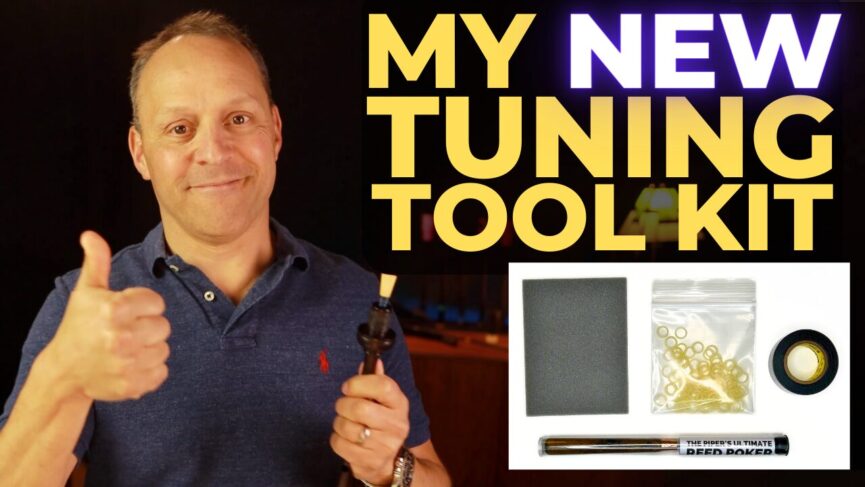
AS FEATURED IN

Why Pipe Bag Size Matters: The Right Fit Can Boost Your Comfort, Control & Performance
by Jori Chisholm, Founder of BagpipeLessons.com
Last Updated: October 15, 2024
In this video, I discuss the crucial role of the pipe bag in achieving optimal bagpipe ergonomics. I’ll explain how pipe bag size and material impact playing comfort, posture, and tone quality. I’ll compare the pros and cons of traditional leather bags versus modern synthetic bags, including innovations like Bannatyne’s hybrid pipe bags, which combine the durability of synthetic materials with the feel of leather.
Watch the video and scroll down to read the full video transcript.
Key Points
🎯 Importance of Pipe Bag Size: The size of your pipe bag significantly impacts comfort, control, posture, and overall playing experience.
👜 Leather vs. Synthetic Bags: Traditional leather bags offer durability and breathability but require regular maintenance, while synthetic bags like Bannatyne hybrids are airtight, maintenance-free, and easier to use.
💧 Moisture Control: A good pipe bag manages moisture from your breath, with synthetic bags offering better moisture control through breathable materials and moisture control systems like the Dri-Flo Bannatyne Lightweight Bagpipe Moisture Control Canister Drying System.
🔧 Zippers and Grommets: Modern synthetic bags feature zippers and rubber grommets, allowing for easy installation and access for moisture control systems.
🚫 Misconceptions About Large Bags: Larger pipe bags do not necessarily offer better air control or performance; in fact, they can make playing more uncomfortable and reduce dexterity.
💪 Smaller Bags for Better Control: A smaller bag fits more securely under your arm, reduces slippage, and gives better leverage and control, especially for maintaining steady bag pressure.
🎨 Custom Pipe Bags: Bannatyne offers custom bag options, including bags with extended necks to accommodate pipers with longer arms, ensuring a comfortable fit.
👶 Super Mini for Young Pipers: For young or small pipers, the “Super Mini” bag is an ideal choice, providing a properly sized instrument to encourage better learning and comfort.
📏 Ergonomics & Blowpipe Position: In addition to the bag size, blowpipe length and angle play a crucial role in achieving comfortable, pain-free piping posture.
🥇 Bannatyne Hybrid Bags: I highly recommend Bannatyne hybrid pipe bags for their combination of a solid leather feel with synthetic durability, available in different sizes including a custom option.
Video Transcript: Welcome back to BagpipeLessons.com! In a previous video, we looked at the importance of your bagpipe blowpipe and how it affects your posture stamina, and playing comfort. Today, we’re diving into another crucial element for good bagpipe ergonomics—your pipe bag. Your bag does more than just hold air; it significantly impacts your posture, comfort, and ability to keep a steady bag pressure. In today’s video, we’ll look at different pipe bag types, discuss their pros and cons, and I show two brand new bag sizes never before released publicly. I’ll tell you which is my favorite pipe bag and why it might be the ideal choice for you. Plus, I’ve share special offer exclusively for viewers of my channel. So, stay tuned—you won’t want to miss this!
Pipe bags are essential components of the bagpipe, serving not only to hold air but also to manage the moisture from your breath as you play. A good pipe bag needs to be as airtight as possible to prevent air loss, while also being breathable enough to allow moisture to escape. And you want your pipe bag to be perfect size and shape for you so you can play comfortably. And since pipers come in a variety of sizes, finding the perfect pipe bag size for you. Traditionally, leather was the go-to material for pipe bags, including varieties made from sheepskin, cow leather, and even kangaroo skin. Pipers have had to make do with the materials available to them, each with its own set of benefits and challenges.
In the past, traditional leather bags were favored by pipers for their durability and their natural breathability. However, leather bags have several drawbacks: they require regular seasoning to maintain air-tightness, can dry out and lose air retention if not played regularly, and can develop a spongy feel due to the stretchiness of the leather. Seasoning the bag could also lead to mold and excessive moisture.
Pipers often prefer the feel of a leather bag, but maintaining these traditional bags can be a challenge. Leather bags are not inherently airtight and require regular seasoning to maintain their integrity. This process can be messy and time-consuming. Additionally, if not maintained properly, leather bags can rot, leading to mold and other issues that not only affect the bag’s performance but can also pose health risks.
One of the earliest synthetic pipe bags was the Ross pipe bag, developed in Australia. Initially, these bags were made from a rubber-like material and which was not breathable. Inside, they were lined with absorbent material similar to a chamois cloth. While this design didn’t really catch on, Ross switched to a more breathable Gore-Tex type material, leading the way for future innovations.
Another early synthetic bag was the Canmore pipe bag, made from Gore-Tex brand material. It’s both breathable and airtight, similar to a Gore-Tex raincoat which keeps rain out while allowing water vapor to escape. The Canmore bag works on the same principle—it’s airtight, but water vapor from the piper’s breath can still escape. This was a pretty cool innovation at the time.
Ross also introduced another significant innovation: a way to access the inside of the pipe bag. This feature is crucial for those who want to use a moisture control system, like a bottle or canister, for additional control. The early Ross bags featured a metal clamp at the back that you could unscrew to get inside. Later versions of Ross bags, and most pipe bags used today, include a zipper. These zippers are airtight and watertight, allowing easy access to the interior for changing or adjusting moisture control systems.
The next big innovation in the world of pipe bags was to combine the airtightness and maintenance-free experience of synthetic bags with the traditional, solid feel of leather bags. This combination is what most pipers play today and is known as a hybrid bag. The Bannatyne Hybrid Pipe Bag, for example, features leather on the outside and a synthetic, breathable layer on the inside. This setup ensures the bag stays completely airtight with no maintenance required—no seasoning needed—and it dries out completely between playing sessions. It also features a high-quality zipper at the bottom of the bag for easy access.
An additional feature of the Bannatyne pipe bag is its ease of installation. Unlike traditional leather bags, which require a tremendous amount of strength and expertise to tie into the stocks with twine or string, these hybrid bags come with rubber grommets. These allow for the installation of a new pipe bag in just minutes.
For those interested in seeing how this installation process works, I have a video on my channel called “Build Your Bagpipes,” where I show the entire process of building a set of pipes—from a box of parts to a playable instrument, including how to install your new Bannatyne Hybrid Pipe Bag. You can find the link to this video in the show notes below.
Achieving a perfect fit with your pipe bag is just as crucial as setting up your blowpipe correctly. Like the blowpipe, your pipe bag needs to be precisely tailored to your body to avoid discomfort and issues with your posture. A poorly fitted bag not only creates physical strain but also makes it hard to keep a steady bag pressure and can actually make it harder to play with clean and consistent finger technique.
When I was just starting out, there was prevalent advice suggesting that pipers should opt for the largest bag possible, promising a “larger reservoir of air” which was supposedly better for sustained play. Following this advice, I chose a large bag, but it quickly turned into a significant struggle. The large bag was tremendously uncomfortable; I couldn’t keep my pipes steady, and maintaining the bag positioned high under my arm was a constant battle.
This ordeal taught me a valuable lesson about the importance of bag size and fit. It’s not about having the most air; it’s about having the right size pipe bag for your body size. A smaller pipe bag is more comfortable, gives you better control and doesn’t slip down.
When your pipe bag and blowpipe are the right size it makes it easier to maintain a neutral posture. Here’s you and here’s you with your pipes. You can keep your head centered, the bag fits comfortably under your arm, stays nice and high and doesn’t slip down, you can reach the chanter easily and your forearms are nice and level. Look at photos or videos of top pipers and you’ll see that their forearms are horizontal or very slightly angled down. Not way up and not reaching way down.
A smaller pipe bag has several advantages. It allows you to push it higher under your arm, securing it in place and reduces slippage. This higher placement provides better leverage and control, enabling you to maintain steady pressure with less physical effort. The result? A more enjoyable playing experience and improved control over your instrument.
Finding the Perfect Bag Size for You
Understanding pipe bag sizing can be quite tricky, especially for those new to piping. Unlike clothing where a medium shirt generally means a medium across brands, pipe bag sizing doesn’t directly translate from your usual clothing size.
Here’s the key takeaway: You want the smallest bag that’s comfortable for you. Smaller bags fit more securely under your arm, providing better leverage and reducing the likelihood of slippage. This secure fit allows for stronger and more controlled squeezing, crucial for maintaining steady airflow. Additionally, a smaller bag frees up your forearm, improving the dexterity of your top hand—essential for executing top-hand embellishments like E and F doublings effectively.
The Most Popular Sizes
There are a lot of options out there for bagpipe products, but at my shop at BagpipeLessons.com, I only sell products that I personally use and recommend. That’s why I sell Bannatyne Hybrid bags. You can check them all out at BagpipeLessons.com/pipebags The most popular sizes are small, extended small, and the Willie McCallum size. Small is the smallest standard size, extended small is extended in the back to give a little more room and it’s also slightly bigger around. Willie McCallum is one of the world’s top pipers and a great friend of mine — he designed this signature model size to be slightly bigger around in the middle and back but more tapered in the front section where your arm goes around the bag. While Bannatyne does manufacture medium and large sizes, I have never sold one nor would I recommend them.
Why Smaller is Better:
- Improved Leverage and Power: A smaller bag allows you to push it higher under your arm, creating a more stable and comfortable playing position.
- Increased Comfort and Reduced Slippage: The higher the bag sits, the less likely it is to slip during play, which is vital during long sessions or performances.
- Enhanced Dexterity: With better leverage and a secure fit, your forearm and wrist remain relaxed, improving your ability to perform intricate fingerwork on the chanter.
How to Choose Between Small, Extended Small, and Willie McCallum Sizes
- Small Size: If you are 5’7” or shorter, the small size is likely ideal. It’s compact and easy to control, perfect for pipers with a smaller frame. But I have had many customers who are taller even up to 6 feet tall who use and love the small.
- Extended Small Size: This size is slightly longer in the back than the small, providing a bit more space without affecting the bag’s diameter significantly.
- Willie McCallum Size: Designed by Willie McCallum in collaboration with Bannatyne, this size offers a good middle ground. It features a tapered front, similar to the extended small, but with a bit more room in the back, accommodating pipers who may need just a little more space than what the extended small offers. This is too big for me, but very popular. If you have been playing a medium or large bag and want to try a smaller size, this one is good one to transition to.
While the three popular sizes of Bannatyne Hybrid pipe bags—small, extended small, and the Willie McCallum size—suit the vast majority of pipers, I’ve encountered special cases where even these options weren’t quite perfect. This realization came through my teaching and interaction with pipers who have unique requirements.
One of my students, he’s around six feet and he feels he’s got long arms, shared his discomfort with the standard bag sizes. He felt that while the circumference of the bags was comfortable, the position of the chanter was too close for his arm length. This posed a unique challenge. Simply opting for a medium or large bag would alter the bag’s position under the arm and shift the blowpipe and drones unfavorably, which wasn’t the solution we wanted.
Instead, we brainstormed and concluded that the best approach was to find a way to maintain the same bag diameter, keeping the drone and blowpipe positions unchanged, but to extend the neck of the bag. This adjustment would move the chanter further out to better accommodate his arm reach without affecting the overall ergonomics under the arm.
I discussed this customization with Bannatyne, and they were able to produce a bag that met these specifications. When my student tried this new bag, which featured a slightly longer neck, he reported that it was the first time his pipes felt truly comfortable. He was so pleased with the outcome that he ordered several more of these custom bags for his other sets of pipes and to keep as spares.
This positive feedback led me to offer this custom option to other students who also struggled with finding the perfect fit from standard sizes. They too have found great success and comfort with this new design.
I’m thrilled to announce that this custom bag, named the Extended Small with Extra-Long Neck, is now available on the BagpipeLessons.com shop. It’s identical to the Extended Small bag but includes an additional 2 inches in the neck length, providing a more comfortable reach to the chanter for pipers with longer arms.
This option has been in the shop for just a few weeks, and the response has been great. I’ve already seen this custom bag purchased by pipers eager to improve their playing comfort. If you’re experiencing similar challenges, I highly encourage you to check out this new option under the custom bags section on the pipe bag main page of our shop.
Now, I absolutely love the Bannatyne Hybrid Small bag—it’s my go-to for most adult pipers. However, there are instances where even the small bag might be too large, particularly for very young players or those of a notably small stature. It is very important that your bagpipe fits you—any age or experience level, but it is especially crucial for beginners.
A proper fitting instrument helps you develop good habits and proper posture from the start. Learning the pipes is hard enough without the added difficulty of handling an instrument that’s too large, which can be painful, demotivating, and disheartening.
In other musical disciplines, like violin playing, instruments are tailored to fit players of all sizes—from adults to very young children—through standardized sizing such as full-size, three-quarter, half, and quarter sizes. This customization allows very young children to begin learning with instruments suited to their size, following methodologies like the Suzuki method.
Unfortunately, this level of customization isn’t typical in the world of bagpipes, where the prevailing attitude has often been “no pain, no gain” or a misguided notion that young players will “grow into” their instruments.
Recognizing this issue, I collaborated with Bannatyne to create a solution specifically for my son, who is learning the pipes. We designed a custom, extra small bagpipe bag. It’s truly small—when you fill and cork it, it’s startlingly compact, yet it perfectly suits his frame. This bag isn’t just about being smaller; it’s about making the learning process as accessible and encouraging as possible for young pipers.
This custom bag, which we’ve named the “Super Mini,” is scaled down by two inches in every dimension compared to our standard small size but still accommodates standard-sized stocks and has the zipper on the bottom. It’s designed to offer the same quality and functionality as our larger bags, ensuring that even the smallest pipers can have a professional-grade setup.
For anyone teaching a young child or for parents whose children are learning to play, the Super Mini is a game-changer. It’s available exclusively at our BagpipeLessons.com shop under the custom pipe bags section. If you find that even the smallest standard size bags are too large, I strongly recommend considering this innovative option.
There’s a third custom bag option available on my site for those who need a bit of extra space without altering the fundamental feel of their setup. It’s a small pipe bag but with a slightly extended back. In terms of playability, it feels identical to a standard small bag. However, the additional space at the back is appreciated by pipers who need more room for canisters, water trap tubes, and other internal setups.
This bag is different from the Extended Small, which is one of the standard sizes offered by Bannatyne. The Extended Small is not only longer in the back but also slightly larger around compared to the small.
The custom bag I’m talking about retains the dimensions that affect how the bag feels under your arm—the diameter, the positioning of the drones, blowpipe, and chanter remain the same as in a regular small bag. The only difference is that it provides additional space in the back where it doesn’t impact the ergonomics of playing. This makes it perfect for pipers who want the comfort and fit of a small bag but need a little extra room for their accessories.
You can find this custom option under the custom pipe bag page on our site, aptly named the Small with Extended Back. If you’re looking for that perfect fit with a bit more storage capacity, be sure to check it out.
I won’t dive into the nitty-gritty of installing the bag since I’ve already covered that extensively in my “Build Your Bagpipes” video on the channel. If you’re looking for a step-by-step guide, definitely check that out—the link is in the description below.
If you are thinking about improving your bagpipe ergonomics with a new pipe bag, I also recommend you check out my other video about ergonomics and the blowpipe. I talk all about the importance of the blowpipe length and also the angle and position. I talk about my invention, called the Perfect Angle Blowpipe Positioner, which allows you to find and adjust the angle of your blowpipe so it sits comfortably in the middle of your mouth and you can relax your mouth completely and let go of the blowpipe and it will stay right there. This means you can play longer with greater comfort and avoid the misalignment and hard clenching down with your teeth on the mouthpiece that can lead to tooth, mouth, and jaw pain and even more serious long-term dental and joint issues like TMJ disorders. So check that video out on the channel, too. The links are below.
So by now, you know why I love the Bannatyne hybrid pipe bags so much. I love the hybrid combination of the synthetic inner layer which keeps thing super airtight yet breathable and dry on the inside and the leather outer layer for the solid traditional feel which makes it easy to keep the pressure steady. My personal favorite is the small size, but they have some great options with the extended small and the popular Willie McCallum size. If you have longer arms, check out the custom extended small with the long neck. For kids, check out the custom Super Mini. And if you love the small bag but want a little extra room on the inside check out the custom small with extended back. Check them all out at the BagpipeLessons.com shop at https://bagpipelessons.com/pipebags
And check out my Perfect Angle™ Blowpipe Positioner at https://bagpipelessons.com/perfectangle
For a limited time, I’m offering $20 off a purchase of any of our pipe bags with the Perfect Angle. Just add them both to the shopping cart and when you check out use the unique coupon code (NEWBAG) I’ve put in the description below just for you and viewers of my Youtube channel.
Don’t miss this opportunity to enhance your piping experience. Upgrade today, and ensure your bagpipe setup is as comfortable and efficient as it can be.
If you found this video helpful and you’re looking to dive deeper into the world of bagpipes, don’t forget to hit that subscribe button. We’ve got plenty more insights and tips coming your way.
For those who want to step up their piping game, consider joining the BagpipeLessons.com Inner Circle. I do weekly online classes for members and you get access to my huge lesson library packed with exclusive tutorials, resources, videos, tunes, and lessons on nearly every piping topic. And you get personalized support from me to help you take your piping to the next level. Check it out at https://bagpipelessons.com/membership/
Also, follow BagpipeLessons.com on Facebook and Instagram for daily updates and more piping content. We love hearing from you, so drop your thoughts and questions in the comments below. Engage with us and let us know what other topics you’d like us to cover.
Thanks again for watching, and happy piping!





